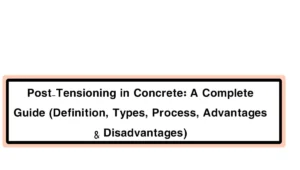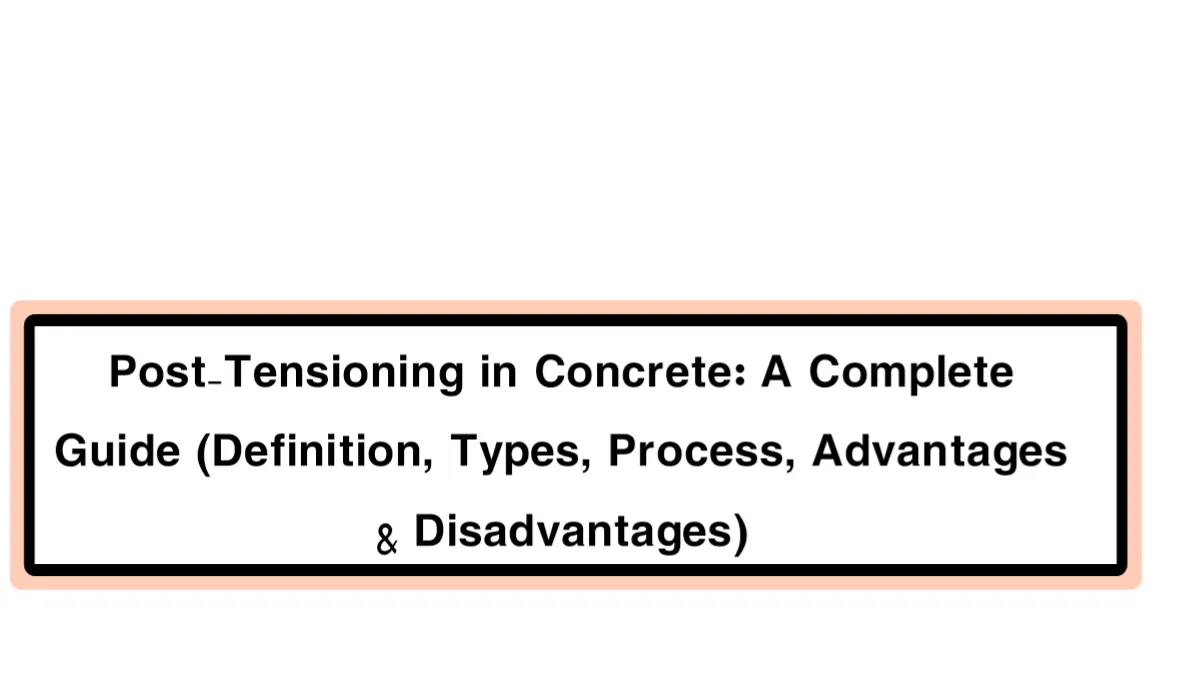Post-Tensioning in Concrete: A Complete Guide (Definition, Types, Process, Advantages & Disadvantages).
Concrete is one of the most commonly used materials in the construction industry due to its high compressive strength and durability. However, concrete is weak in tension. To overcome this limitation, Post-Tensioning (PT) technology is widely used in modern construction. It enhances concrete’s performance, especially in large-span structures like bridges, commercial buildings, and parking garages.
Post-Tensioning in Concrete
In this post, we’ll explore everything you need to know about Post-Tensioning in Concrete — its definition, types, working process, benefits, limitations, and real-life applications.
What is Post-Tensioning?
Post-Tensioning is a method of pre-stressing concrete in which steel tendons or cables are tensioned after the concrete has been cast and has gained sufficient strength. This process enhances the concrete’s ability to resist tension forces and improves its structural performance.
It’s different from pre-tensioning, where the tendons are tensioned before pouring the concrete.
Why is Post-Tensioning Needed?
Concrete is naturally strong in compression but weak in tension. In large-span or load-bearing structures, tension can lead to cracks or failure. Post-tensioning helps by applying compressive force to the concrete to counteract the tensile stresses.
Benefits of post-tensioning:
- Reduces or eliminates cracks
- Allows for longer spans
- Reduces slab thickness
- Improves load-carrying capacity
How Post-Tensioning Works – Step-by-Step
Here is how the post-tensioning process works in construction:
Duct Placement:
- Plastic or metal ducts are laid in the formwork where the tendons will pass.
- These ducts are curved or straight depending on design.
Casting Concrete:
- Concrete is poured and allowed to gain strength (typically 70–80% of final strength).
Tendon Installation:
- High-strength steel tendons or strands are threaded through the ducts.
Tensioning:
- Once the concrete has cured, hydraulic jacks are used to pull (tension) the tendons.
Anchoring:
- The tendons are anchored at each end, transferring compressive stress to the concrete.
Grouting (optional):
- In bonded post-tensioning, ducts are filled with grout to protect tendons from corrosion and bond them to concrete.
Types of Post-Tensioning Systems
There are two primary types of post-tensioning systems:
1. Bonded Post-Tensioning
- Uses ducts filled with grout after tensioning.
- Tendons are bonded to the concrete.
- Used in bridges, buildings, slabs, etc.
- Offers better long-term performance and crack control.
2. Unbonded Post-Tensioning
- No grout is used; tendons move freely inside sheathed ducts.
- Mostly used in slabs and buildings.
- Easier and quicker to install.
- Slightly less durable than bonded systems.
Components Used in Post-Tensioning
- Tendons – High-strength steel strands or wires.
- Ducts – Plastic or metal conduits for tendons.
- Anchorages – Used to fix the tendons at ends after tensioning.
- Hydraulic Jack – Applies tension force to steel tendons.
- Grout (Bonded systems) – Cementitious material to fill ducts.
Applications of Post-Tensioned Concrete
Post-tensioning is commonly used in:
- Long-span bridges
- Multi-storey buildings
- Industrial floors and warehouses
- Parking garages
- Water tanks and reservoirs
- Silos and towers
- Stadiums and auditoriums
✅ Advantages of Post-Tensioning
1. Longer Spans:
- Post-tensioned members can span greater distances with less material.
2. Reduced Structural Thickness:
- Saves on concrete and reinforcement.
3. Crack Control:
- Better resistance to cracking under service loads.
4. Economical:
- Reduces the overall weight of the structure, leading to savings in foundation cost.
5. Faster Construction:
- Allows quicker removal of formwork and reduces construction time.
6. Design Flexibility:
- Suitable for curved structures and architectural freedom.
7. Improved Seismic Performance:
- Enhances the ductility and energy absorption during earthquakes.
❌ Disadvantages of Post-Tensioning
1. Higher Initial Cost:
- Specialized equipment and skilled labor increase initial investment.
2. Complex Construction Process:
- Requires experienced engineers and proper quality control.
3. Inspection & Maintenance Challenges:
- In unbonded systems, it’s harder to detect and repair damaged tendons.
4. Risk of Tendon Corrosion:
- If not grouted or protected properly.
5. Not Ideal for Small Projects:
- Cost and setup may not be justified for smaller buildings.
⚙️ Post-Tensioning vs Pre-Tensioning
| Feature | Post-Tensioning | Pre-Tensioning |
|---|---|---|
| Tension Applied | After concrete hardens | Before pouring concrete |
| Site Work | Performed on-site | Mostly done in precast factories |
| Flexibility | High (in-situ casting) | Limited |
| Common Usage | Bridges, slabs, buildings | Precast beams, poles, railway ties |
| Cost | Higher initial setup cost | Economical in mass production |
Conclusion
Post-tensioning is a powerful technique that enhances the performance and longevity of concrete structures. With the increasing demand for tall buildings, long-span bridges, and cost-effective designs, post-tensioning has become an essential tool for modern construction engineers. While it may require a higher initial investment and skilled labor, the benefits in terms of durability, strength, and design efficiency make it well worth the cost for large-scale projects.
Home Page: Click Here

